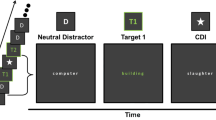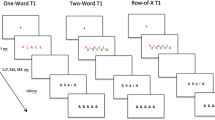Abstract
The attentional blink (AB) refers to the finding that performance on the second of two targets (T1 and T2) is impaired when the targets are presented at a target onset asynchrony (TOA) of less than 500 ms. One account of the AB assumes that the processing load of T1 leads to a loss of top-down control over stimulus selection. The present study tested this account by examining whether an endogenous spatial cue that indicates the location of a following T2 can facilitate T2 report even when the cue and T2 occur within the time window of the AB. Results from three experiments showed that endogenous cuing had a significant effect on T2 report, both during and outside of the AB; this cuing effect was modulated by both the cue-target onset asynchrony and by cue validity, while it was invariant to the AB. These results suggest that top-down control over target selection is not lost during the AB.




Similar content being viewed by others
References
Bowman H, Wyble B (2007) The simultaneous type, serial token model of temporal attention and working memory. Psychol Rev 114:38–70
Broadbent DE, Broadbent MHP (1987) From From detection to identification—response to multiple targets in rapid serial visual presentation. Percept Psychophys 42:105–113
Chun MM (1997) Temporal binding errors are redistributed by the attentional blink. Percept Psychophys 59:1191–1199
Chun MM, Potter MC (1995) A two-stage model for multiple target detection in rapid serial visual presentation. J Exp Psychol Hum Percept Perform 21:109–127
Corbetta M, Shulman GL (2002) Control of goal-directed and stimulus-driven attention in the brain. Nat Rev Neurosci 3:201–215
Corbetta M, Tansy AP, Stanley CM, Astafiev SV, Snyder AZ, Shulman GL (2005) A functional MRI study of preparatory signals for spatial location and objects. Neuropsychologia 43:2041–2056
Di Lollo V, Kawahara J, Ghorashi SMS, Enns JT (2005) The attentional blink: resource depletion or temporary loss of control? Psychol Res-Psychol Forsch 69:191–200
Duncan J, Ward R, Shapiro K (1994) Direct measurement of attentional dwell time in human vision. Nature 369:313–315
Eriksen CW, Yeh YY (1985) Allocation of attention in the visual-field. J Exp Psychol Hum Percept Perform 11:583–597
Ghorashi SMS, Di Lollo V, Klein RM (2007) Attentional orienting in response to peripheral cues survives the attentional blink. Vis Cogn 15:87–90
Giesbrecht B, Di Lollo V (1998) Beyond the attentional blink: visual masking by object substitution. J Exp Psychol Hum Percept Perform 24:1454–1466
Hommel B, Pratt J, Colzato L, Godijn R (2001) Symbolic control of visual attention. Psychol Sci 12:360–365
Hopfinger JB, Buonocore MH, Mangun GR (2000) The neural mechanisms of top-down attentional control. Nat Neurosci 3:284–291
Isaak MI, Shapiro KL, Martin J (1999) The attentional blink reflects retrieval competition among multiple rapid serial visual presentation items: tests of an interference model. J Exp Psychol Hum Percept Perform 25:1774–1792
Jefferies LN, Ghorashi SM, Kawahara J, Di Lollo V (2007) Ignorance is bliss: the role of observer expectation in dynamic spatial tuning of the attentional focus. Percep Psychophys (in press)
Jiang YH, Chun MM (2001) The influence of temporal selection on spatial selection and distractor interference: an attentional blink study. J Exp Psychol Hum Percept Perform 27:664–679
Jolicoeur P, Dell’ Acqua R (1998) The demonstration of short-term consolidation. Cognit Psychol 36:138–202
Jonides J (1980) Towards a model of the minds eyes movement. Can J Psychol 34:103–112 (Revue Canadienne De Psychologie)
Jonides J (1981) Voluntary versus automatic control over the mind’s eye’s movement. In: Long JB, Baddeley AD (eds) Attention and performance IX. Lawrence Erlbaum, Hillsdale, pp 187–203
Jonides J (1983) Further toward a model of the minds eyes movement. Bull Psychon Soc 21:247–250
Kanwisher N, Wojciulik E (2000) Visual attention: insights from brain imaging. Nat Rev Neurosci 1:91–100
Kawahara JI, Kumada T, Di Lollo V (2006) The attentional blink is governed by a temporary loss of control. Psychon Bull Rev 13:886–890
LaBerge D (1997) Attention, awareness, and the triangular circuit. Conscious Cogn 6:149–181
LaBerge D (2001) Attention, consciousness, and electrical wave activity within the cortical column. Int J Psychophysiol 43:5–24
LaBerge D, Brown V (1989) Theory of attentional operations in shape identification. Psychol Rev 96:101–124
LaBerge D, Carlson RL, Williams JK, Bunney BG (1997) Shifting attention in visual space: tests of moving-spotlight models versus an activity-distribution model. J Exp Psychol Hum Percept Perform 23:1380–1392
Madden DJ (1992) Selective Selective attention and visual-search—revision of an allocation model and application to age-differences. J Exp Psychol Hum Percept Perform 18:821–836
Marois R, Ivanoff J (2005) Capacity limits of information processing in the brain. Trends Cogn Sci 9:296–305
Martens S, Johnson A (2005) Timing attention: cuing target onset interval attenuates the attentional blink. Mem Cogn 33:234–240
Miller EK (2000) The prefrontal cortex and cognitive control. Nat Rev Neurosci 1:59–65
Miller BT, D’Esposito M (2005) Searching for “the top” in top-down control. Neuron 48:535–538
Muller HJ, Rabbitt PMA (1989) Reflexive and voluntary orienting of visual-attention—time course of activation and resistance to interruption. J Exp Psychol Hum Percept Perform 15:315–330
Nakayama K, Mackeben M (1989) Sustained and transient components of focal visual-attention. Vision Res 29:1631–1647
Nieuwenhuis S, Gilzenrat MS, Holmes BD, Cohen JD (2005) The role of the locus coeruleus in mediating the attentional blink: a neurocomputational theory. J Exp Psychol Gen 134:291–307
Nieuwenstein MR (2006) Top-down controlled, delayed selection in the attentional blink. J Exp Psychol Hum Percept Perform 32:973–985
Nieuwenstein MR, Chun MM, van der Lubbe RHJ, Hooge ITC (2005) Delayed attentional engagement in the attentional blink. J Exp Psychol Hum Percept Perform 31:1463–1475
Olivers CNL (2007) The time course of attention: it’s better than we thought. Curr Dir Psychol Sci 16:11–15
Olivers CNL, van der Stigchel S, Hulleman J (2007) Spreading the sparing: against a limited-capacity account of the attentional blink. Psychol Res Psychol Forsch 71:126–139
Posner MI (1980) Orienting of attention. Q J Exp Psychol 32:3–25
Potter MC, Chun MM, Banks BS, Muckenhoupt M (1998) Two attentional deficits in serial target search: the visual attentional blink and an amodal task-switch deficit. J Exp Psychol Learn Mem Cogn 24:979–992
Praamstra P, Boutsen L, Humphreys GW (2005) Frontoparietal control of spatial attention and motor intention in human EEG. J Neurophysiol 94:764–774
Raymond JE, Shapiro KL, Arnell KM (1992) Temporary suppression of visual processing in an RSVP task—an attentional blink. J Exp Psychol Hum Percept Perform 18:849–860
Riggio L, Kirsner K (1997) The relationship between central cues and peripheral cues in covert visual orientation. Percept Psychophys 59:885–899
Ristic J, Friesen CK, Kingstone A (2002) Are eyes special? it depends on how you look at it. Psychon Bull Rev 9:507–513
Rounis E, Stephan KE, Lee L, Siebner HR, Pesenti A, Friston KJ, Rothwell JC, Frackowiak RSJ (2006) Acute changes in frontoparietal activity after repetitive transcranial magnetic stimulation over the dorsolateral prefrontal cortex in a cued reaction time task. J Neurosci 26:9629–9638
Shapiro KL, Raymond JE, Arnell KM (1994) Attention to visual pattern information produces the attentional blink in rapid serial visual presentation. J Exp Psychol Hum Percept Perform 20:357–371
Slagter HA, Kok A, Mol N, Talsma D, Kenemans JL (2005) Generating spatial and nonspatial attentional control: an ERP study. Psychophysiology 42:428–439
Vossel S, Thiel CM, Fink GR (2006) Cue validity modulates the neural correlates of covert endogenous orienting of attention in parietal and frontal cortex. Neuroimage 32:1257–1264
Vul E, Nieuwenstein MR, Kanwisher N (2007) Temporal selection is suppressed, delayed, and diffused during the attentional blink. Psychol Sci (in press)
Ward R, Duncan J, Shapiro K (1996) The slow time-course of visual attention. Cogn Psychol 30:79–109
Yantis S, Serences JT (2003) Cortical mechanisms of space-based and object-based attentional control. Curr Opin Neurobiol 13:187–193
Acknowledgments
This study was supported by grants from the Natural Science Foundation of China (30470569, 60435010, and 30770712). We thank two anonymous reviewers for their constructive comments on the earlier versions of the paper. Electronic mail concerning this study should be addressed to Dr. Xiaolin Zhou (xz104@pku.edu.cn).
Author information
Authors and Affiliations
Corresponding author
Rights and permissions
About this article
Cite this article
Zhang, D., Shao, L., Nieuwenstein, M. et al. Top-down control is not lost in the attentional blink: evidence from intact endogenous cuing. Exp Brain Res 185, 287–295 (2008). https://doi.org/10.1007/s00221-007-1153-3
Received:
Accepted:
Published:
Issue Date:
DOI: https://doi.org/10.1007/s00221-007-1153-3




